Yes, you still have time to see the super bloom — if you know where to go
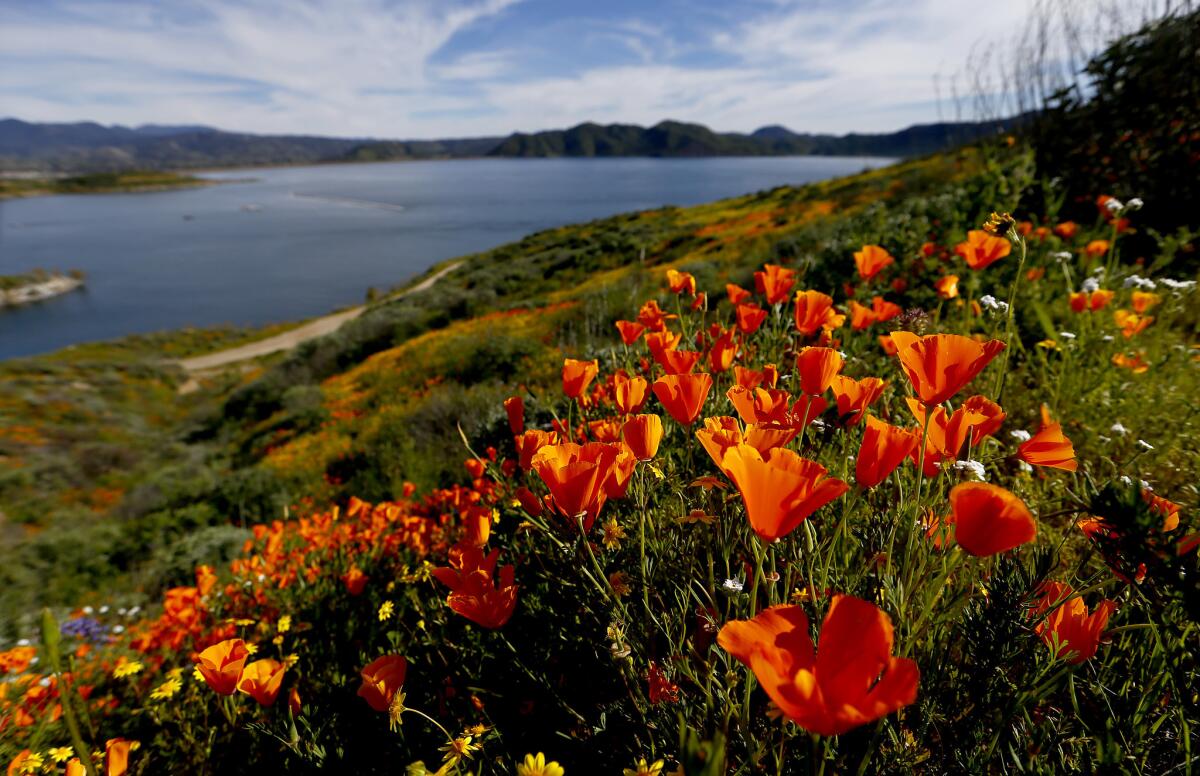
Blazing fields of desert dandelions, streaks of purple lupine and pink sand verbena, and poppies bursting along hillsides have transformed Southern California. There’s still plenty of time to see this season’s outstanding bloom of annual wildflowers, if you know where to go.
“It’s cooler right now, which means we may have an extended wildflower bloom,” said Larry Hendrickson, a botanist with Anza-Borrego Desert State Park about 160 miles southeast of L.A.
Chasing desert wildflowers, even in a big, wet year, can be daunting, because they don’t bloom everywhere and they don’t bloom at the same time. The other daunting factor? Mobs of people who crave that uniquely California touch of nature.
In mid-March, I took off to find the best wildflower destinations, places expected to hang in there for the a few weeks. My quest fueled by hope, stamina and lots of gas covered 746 miles in 2½ days — and revealed spectacular and often unexpected wildflower blooms at Anza-Borrego Desert State Park, the southern end of Joshua Tree National Park, various spots in Mojave Trails National Monument and the incomparable hills surrounding Diamond Valley Lake near Hemet.
The show will continue through June at higher elevations. Cactus, yucca and agave, for example, usually bloom until mid-May in Anza-Borrego’s Culp Valley, a cool desert high spot at 3,400 feet.

Anza-Borrego Desert State Park
This is the It park for wildflowers in 2019. Much-needed rain started in December and continued into February, each downpour sparking a new generation of seeds to germinate. Cool temperatures at critical times during fall and winter sealed the deal for a banner season.
Hendrickson called it “a very good bloom,” avoiding the nonscientific “super bloom” label that created chaos recently in Lake Elsinore. In 2017, a big bloom at the park drew thousands of visitors, who clogged traffic and left behind garbage, trampled flowers and bad feelings.
This year, the town and the park better prepared for the crush by placing portable toilets near heavily used areas and handing out maps to the flower fields to direct people.
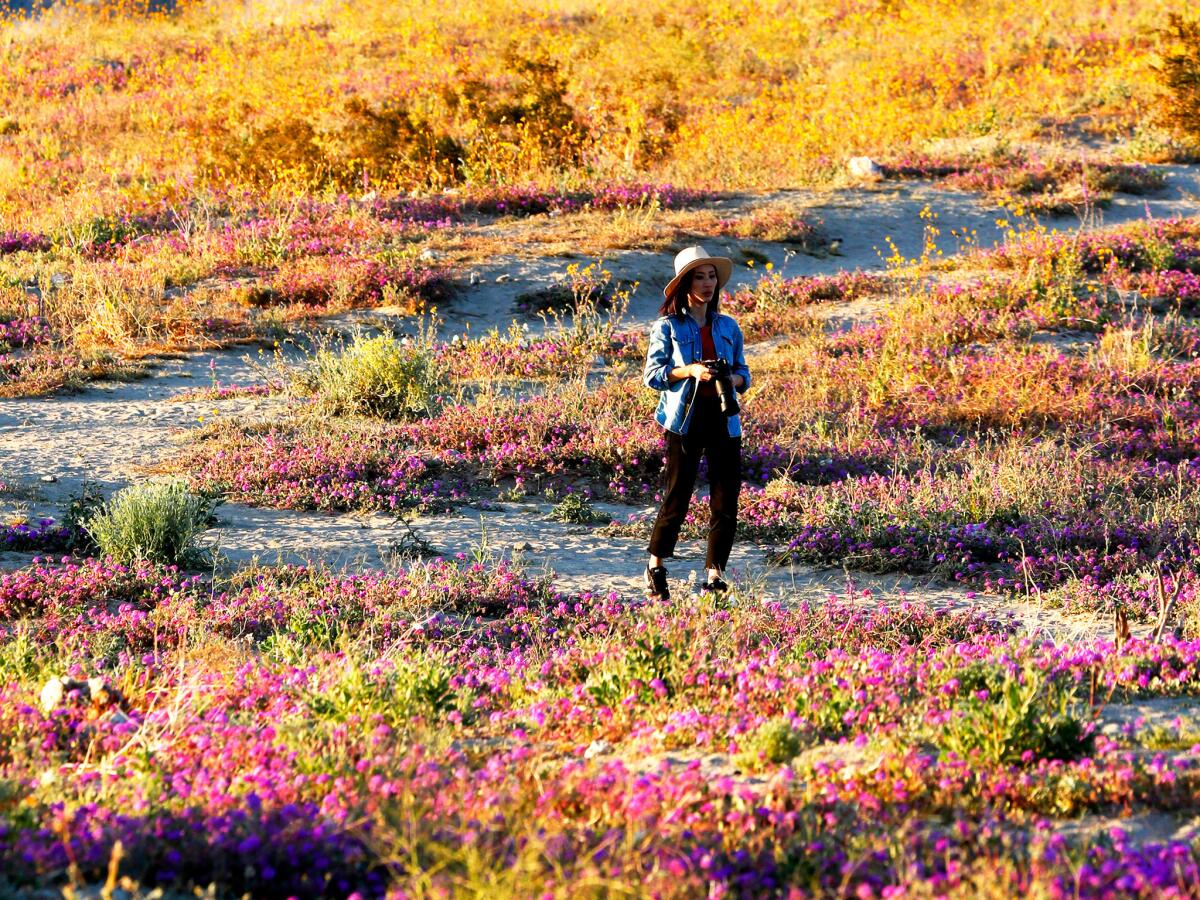
Quick list of where to find the super blooms in Southern California »
Here are some places to look:
Visitor center: Start here, where more than 2,000 people swing by on a super bloom weekend. Expect long lines. Still, it’s a good place to ask questions, grab a map and a flower guide.
Easy walking within a quarter- or half-mile turned up ground-hugging purple mat, wild heliotrope (purple), thick stands of bricklebush (yellow), fluffy white Fremont’s pincushion and little balls of white popcorn flower.
Go to the park’s website for up-to-date reports on where wildflowers are blooming and a downloadable map that shows the best places to see them.
Info: The visitor center at 200 Palm Canyon Drive is open 9 a.m. to 5 p.m. daily through May. Parking costs $10, but the road sometimes closes temporarily when the parking lot fills up. (760) 767-4205, Anza-Borrego Desert State Park
Coyote Canyon: I struck gold before I even got to the end of paved Di Giorgio Road and the entrance to the canyon: Low-to-the-ground desert dandelions created a vast wave of yellow that riffled in a soft wind. Coyote Canyon usually makes the must-see list in a good bloom year, and for good reason. It’s the largest watershed in the park, and seeds thrive here.
PHOTOS: Poppy fields in Lake Elsinore's Walker Canyon reopen to the public »
I parked where the paved road ended (as did plenty of other visitors) and headed east on foot, following a flat path. It was easy to find a rich variety of plants: yellow desert sunflowers; large, white dune primroses, the park’s signature wildflower; lupine in shades of blue and purple; bright pink sand verbena; and desert lilies, with white trumpet-shaped flowers on slender green stems.
On the way out of the canyon, I stopped at a field with no wildflowers but plenty of scrap-metal sculptures, including a fantastic giant scorpion facing off against an equally huge grasshopper. The works are among 130 creatures and characters created by self-trained artist Ricardo Breceda that are scattered around Galleta Meadows Estate, private property holdings near the park and Borrego Springs that are open to the public.
From Christmas Circle in Borrego Springs, go east on Palm Canyon Drive and north on Di Giorgio Road. Park at the end of the paved road and walk east to the flower fields. Four-wheelers can continue on the dirt route into Lower Coyote Canyon but should check road conditions beforehand. Parking is free.
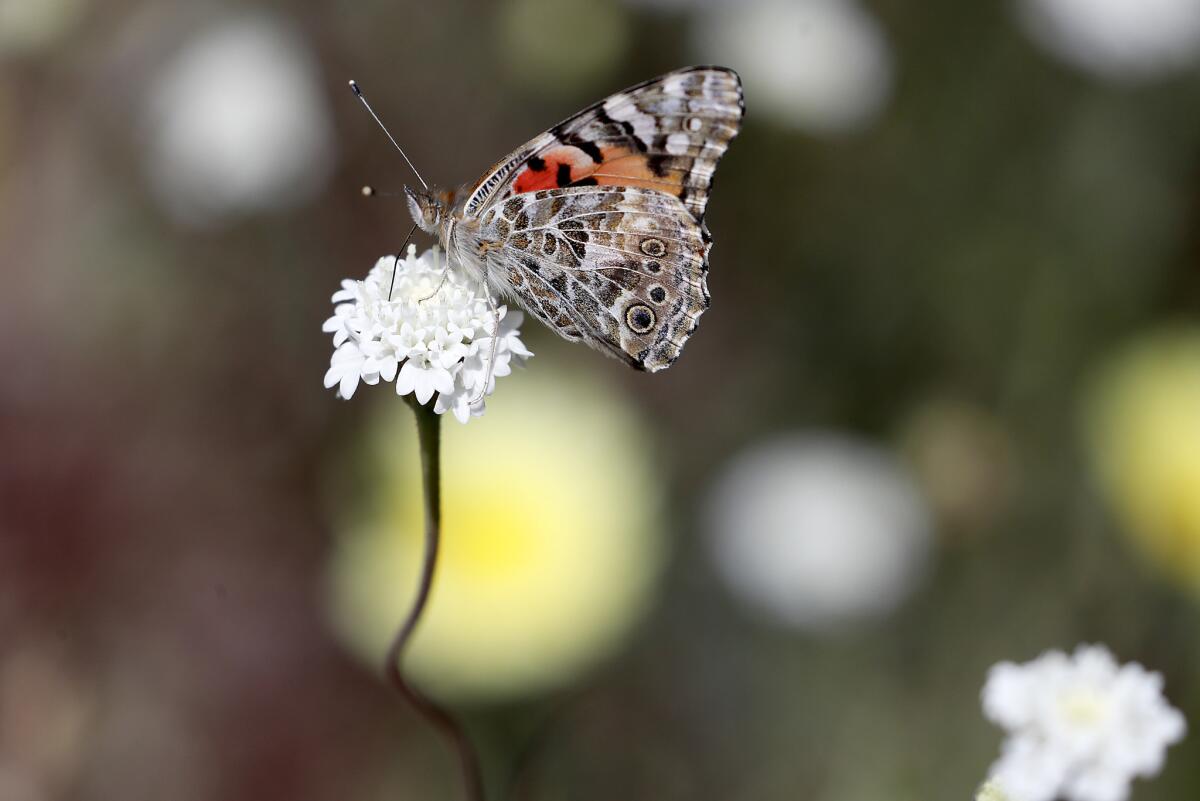
The Texas Dip: “You've seen the poppies, right? They're amazing,” a woman shouted at me before dashing off to her next wildflower spot. Yellow poppies were abundant on southern-facing slopes in the dip, a wide, low spot on Borrego Springs Road known on the map as San Felipe Wash.
Driving slowly, I scanned the hillside until my eyes watered. Nothing. It wasn’t until I parked the car and walked about a quarter mile into the wash that I found pale yellow rivers of poppies on the hills. Something wasn’t right.
I glanced at my watch and realized I had made a rookie mistake: It was past 5 p.m. and though the sun hadn’t yet set, the light-loving poppies had closed up, shut into tight little whorls. The show was over for the day, and I had missed it.
Are crowds ruining California’s super bloom? »
Retracing my steps, I found thick barrel cactuses, some a few feet tall, with crowns of waxy yellowish flowers the size of a baby’s fist. I counted as many as 10 blooms on some. The lowering sun that had shut down the poppy show lighted the cactus flowers to produce an astonishing glow. I felt vindicated.
From Christmas Circle in Borrego Springs, take Borrego Springs Road south and park along the road at the bottom of the dip, about a mile from California 78. Walk into the wash on either side of the road.
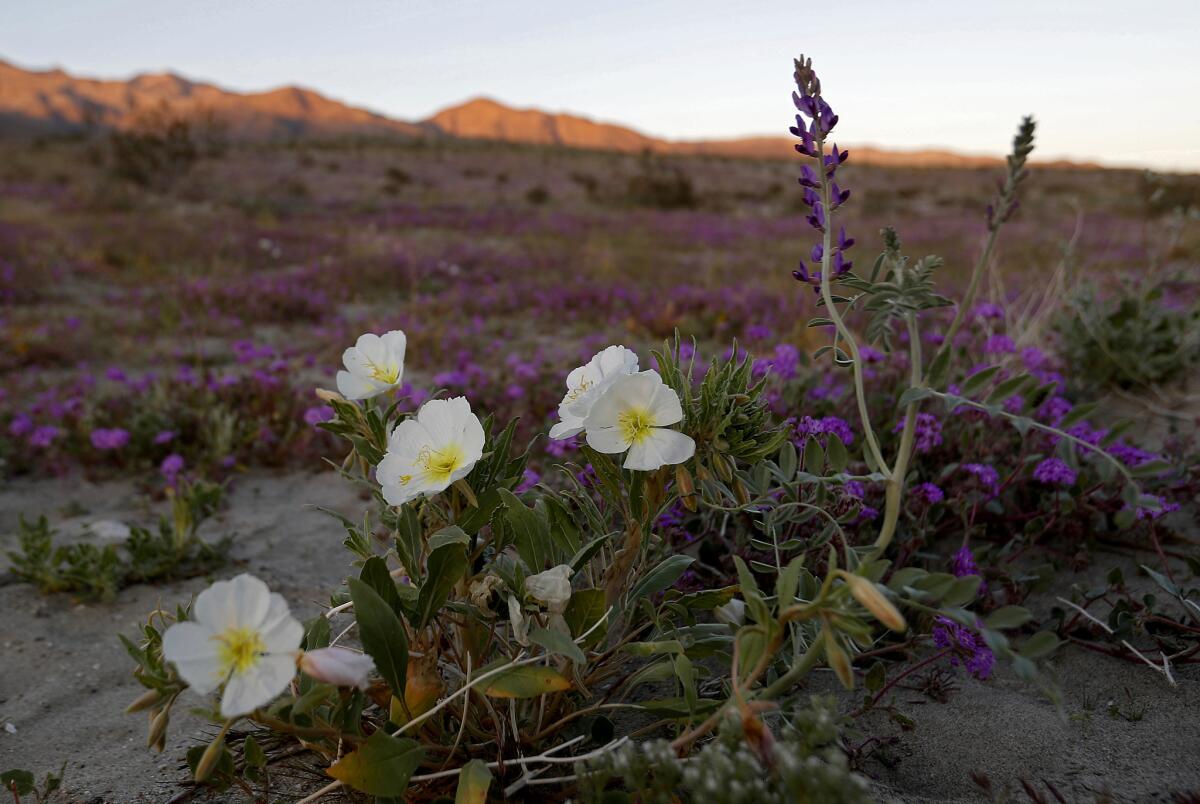
Cactus Loop Trail: The one-mile trail across from the Tamarisk Grove Campground was thick with poppies and “belly” flowers (ones so small you have to get on your belly to see) amid the barrel, fishhook and cholla cactuses on this route. It’s an easy trail but climbs uphill a bit from the road.
Park on the road outside the campground at 5960 Yaqui Pass Road in Julian, Calif. The well-marked trail is easy to find.
Up and coming: Wildflowers along Henderson Canyon Road, the darling spot of the 2017 super bloom, were starting to pop on my visit. This is an easy drive-up spot but can be crowded because it’s so popular. As of last week, the park reported dune evening primrose and sand verbena were blooming, but sunflowers were still in bud.
From Christmas Circle in Borrego Springs, head north on Borrego Springs Road and east onto Henderson Canyon Road. Park on the side of the road.
Near Joshua Tree National Park
The sides of the road leading to the southern entrance of the park looked like a lupine forest, tall purple stalks interspersed with yellow brickelbush and tall red-flowering ocotillos. It’s easy walking alongside the road to see pockets of wildflowers amid the rocky landscape. You don’t need to enter the park (and pay the $30 fee) to see the flowers.
Info: From Interstate 10, take Exit 168 onto Cottonwood Springs Road and head north.
Near Desert Lily Sanctuary
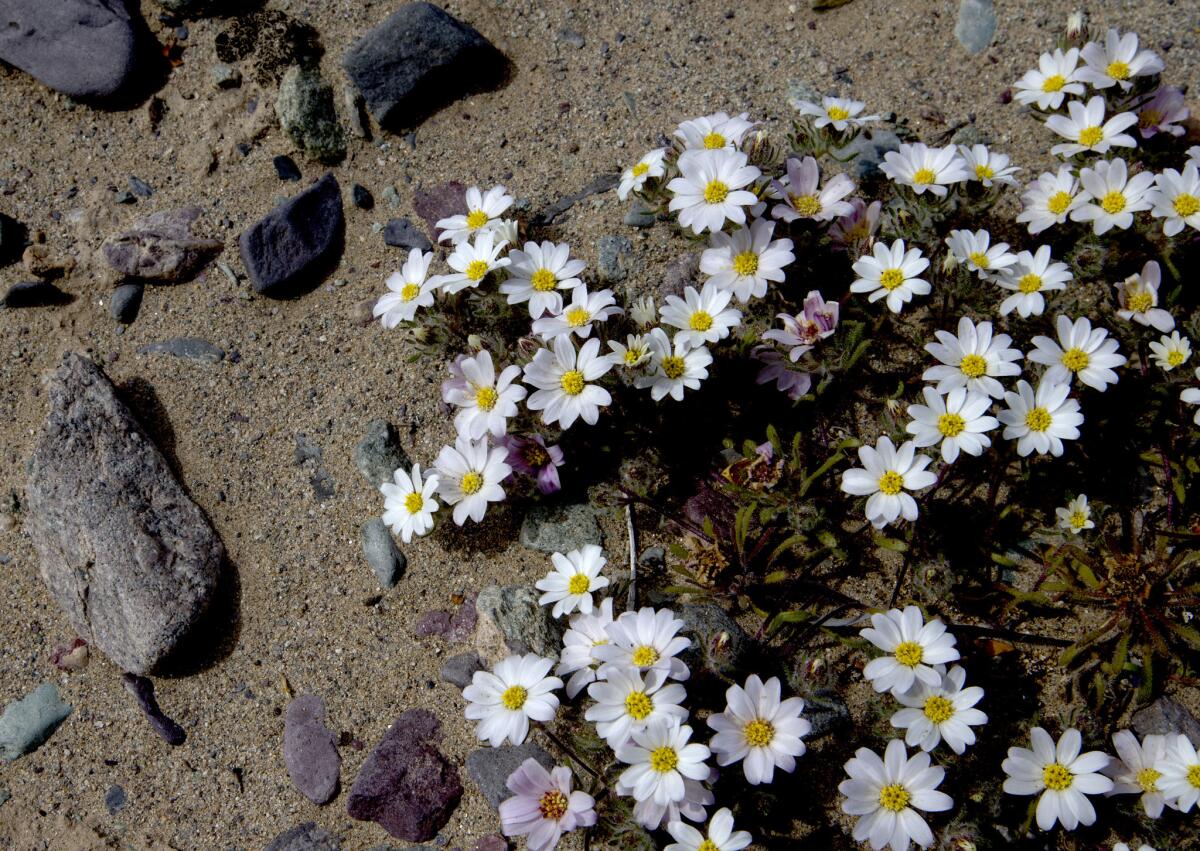
The namesake lilies appeared in scattered places in the 2,000-acre protected area near the southeastern corner of Joshua Tree National Park, about 185 miles east of downtown Los Angeles. But the deep pink sand verbena stole the show. Verbena plants love the same dry, sandy flats as lilies, which made for an impressive roadside display at a spot along lightly trafficked California 177.
Info: Park at the Desert Lily Sanctuary lot on California 177, seven miles northeast of Desert Center. Then walk less than a quarter mile south along 177 to find the verbena display.
Mojave Trails National Monument
To escape the crowds, I looked to one of the country’s newly designated federal lands, Mojave Trails, a bat-shaped parkland of 1.6 million acres that takes you into the heart of the Mojave Desert.
With staffers from the Bureau of Land Management and the Mojave Desert Land Trust leading the way, I found gorgeous patches of lupine, desert dandelions and shrubby creosote — with no one else in sight. This is a great place for four-wheelers to take off on dirt roads in search of blooms.
I found good wildflowers along Amboy Road, specifically on the southern side of Sheephole Pass, and at Amboy Crater, an extinct cinder cone volcano that’s also part of the monument. Wildflowers were more sparse at the crater, but I loved how the yellow daisies and pink verbena contrasted beautifully against the black volcanic rock.
Info: From Twentynine Palms, go north on Amboy Road and pull off the road when you see flowers; you’ll probably have the desert mostly to yourself. Continue north to Amboy Crater, which connects with Route 66. You’ll find free parking, a bathroom and picnic tables. Follow the well-marked, easy trail to the cinder cone.
Diamond Valley Lake, Hemet
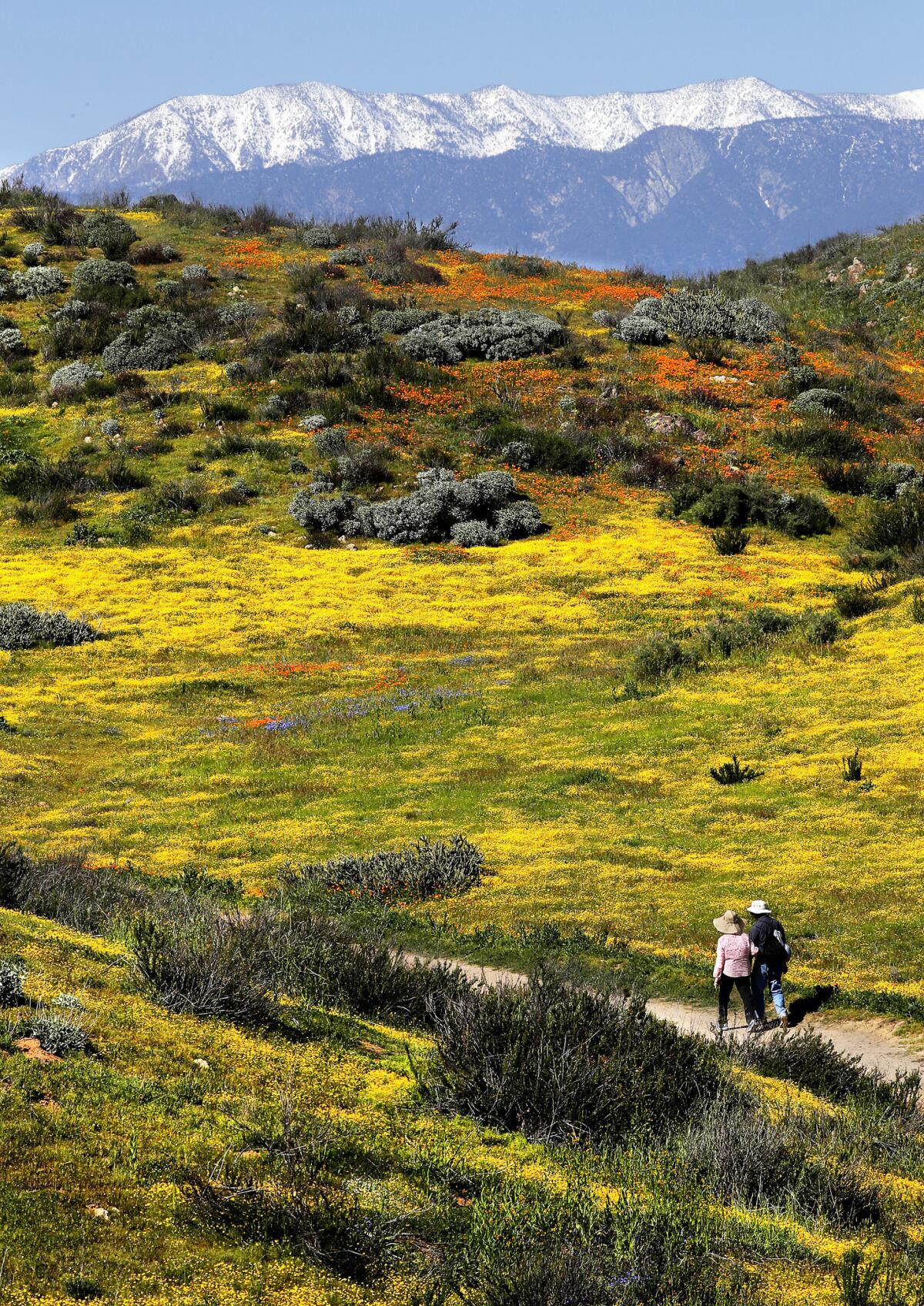
On my way back to L.A., I decided to stop at Diamond Valley Lake in Hemet, about 90 miles southeast of Los Angeles — and was glad I did.
The hills surrounding the man-made reservoir had some of the most vivid wildflower displays: brilliant patches of orange poppies, deep blue lupine, purplish-blue Canterbury bells and bright yellow goldfields.
To see wildflower displays, expect to walk at least half-a-mile on easy dirt trails that start at the lake’s marina parking lot. I hiked to a high point on a 1.3-mile loop trail and hit a trifecta of views: flowers, snow-capped mountain peaks and the lake’s deep blue waters. Some said the 2017 bloom was better, but this spot was my hands-down favorite for plant variety and colors.
Info: Trails start at Diamond Valley Lake Marina, 2615 Angler Ave., Hemet; (951) 926-7201. The wildflower loop trail is open 9 a.m. to 4 p.m. Wednesdays through Sundays through the end of the flower season.
Other trails to the flowers are open year-round starting at 7 a.m., but the best time to see poppies is between 9 a.m. and 3 p.m. when they are open.
Parking costs $10; it’s $3 a person for a trail fee, which includes a flower guide and trail map.
Viewing tips
- Plan. Contact individual parks for a flower report and/or consult with the Theodore Payne Wildflower Hotline, which updates blooms every Friday. Info: (818) 768-1802, Ext. 7
- If you can, visit midweek to avoid the heavy traffic on weekends.
- Carry plenty of water and snacks; places to buy food may be far from where you are hiking or stopping. Wear boots or sturdy shoes, use sunscreen, and carry water with you at all times.
- Make sure you have a map of the area you’re visiting. Cellphone coverage is spotty in many areas of the desert, and you may not be able to access directions.
- Many desert areas lack facilities, so plan accordingly. For example, don’t expect to find garbage cans at every site. Make sure you pack out your own trash.
- In state parks, dogs aren’t allowed on trails or in the wildflower fields. You can take them on designated roads and campgrounds, but always on a leash.
- More info on Southern California wildflowers
Sign up for The Wild
We’ll help you find the best places to hike, bike and run, as well as the perfect silent spots for meditation and yoga.
You may occasionally receive promotional content from the Los Angeles Times.




